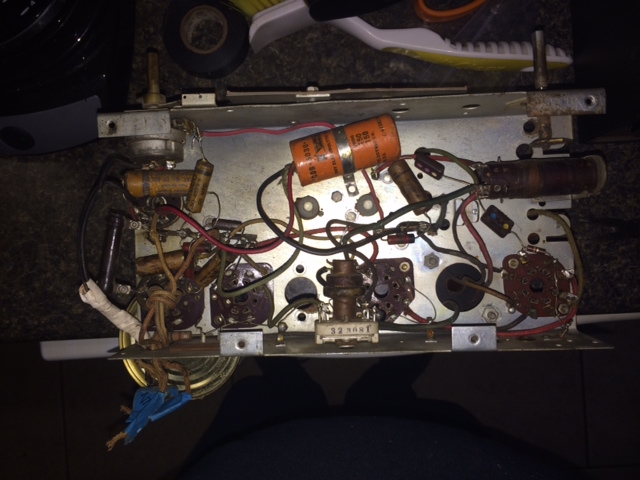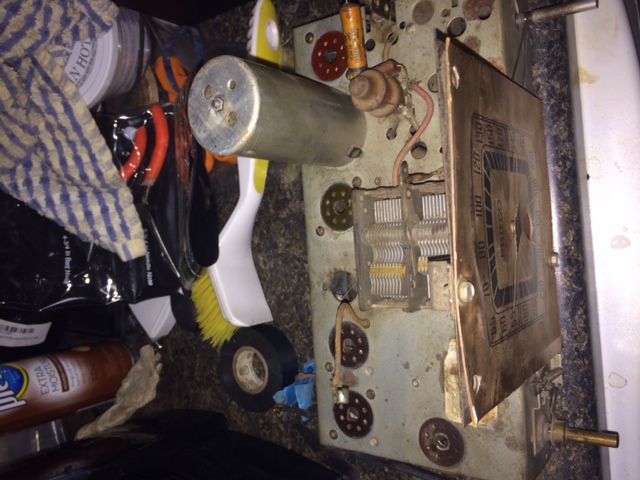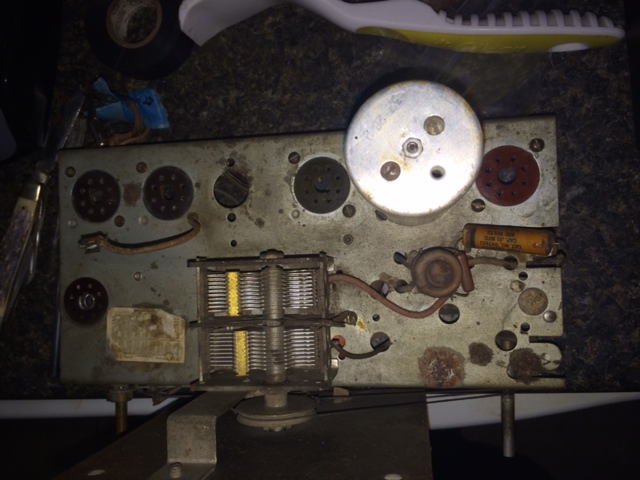10-28-2014, 02:34 PM
I recently bought a 39-70 tombstone farm radio from ebay. When I pulled the chassis I found a very NOT 37-70 tube line up. Any help on this puzzle is appreciated because a schematic would be handy lol.



|
my 4 tube battery set 39-70 has 5 tubes and an AC cord??
10-28-2014, 02:34 PM
I recently bought a 39-70 tombstone farm radio from ebay. When I pulled the chassis I found a very NOT 37-70 tube line up. Any help on this puzzle is appreciated because a schematic would be handy lol.
10-28-2014, 04:12 PM
I wonder if this is 39-70 modified.
Like, underneath there is no output transformer. Maybe the 5th tube was added to drive some other sort of speaker? The dial does look like 39-70 (or a couple of others that used similar chassis).
10-28-2014, 04:52 PM
The speaker in the cabinet is a zenith. The odd ball tube socket is screwed in not rivited and the chassis has the typical 39-5955 patent sticker...puzzling
10-28-2014, 04:53 PM
there is also the glaring absense of a transformer period
10-28-2014, 04:59 PM
If it was rewired to an aa5 it wouldn't have a transformer.
10-28-2014, 05:04 PM
See if it is a ballast tube.
There should be then a rectifier also. In any case I think it is a modded chassis.
10-28-2014, 05:21 PM
Please list the tube line up, since this thing was made just before WWII may have been converted to run of the mains because nothing else was available. Don't know the tube sockets for the orginal tubes compared to the tubes in a 38-8 but parts wise might work! David
10-28-2014, 05:59 PM
Tube line up 35Z3, 50L6GT, 12Q7, 125K7, 12SA7 GT/G
10-28-2014, 06:01 PM
written in pencil on the chassis is "Do Not Ground This Set"
10-28-2014, 06:39 PM
Seems someone converted a farm set to a standard "all American 5" setup.
10-28-2014, 06:47 PM
I guess that makes it a Philco Farm Five!
10-28-2014, 07:40 PM
That would be Philco Pharm Phive.
10-28-2014, 07:59 PM
Good thing is, it needs not any ballast.
10-28-2014, 08:42 PM
Looking at the tube line up and comparing to data sheets the person who did the change over knew his stuff. Orginal audio amp tube 1H5G which has a grid cap, 12Q7 also has a grid cap replace tube socket and rewire. Post war tube 12SQ7 no grid cap. The more common rectifier tube in a AA5 would have been 35Z5 but your set has a 35Z3 LOK base tube. Me thinks war time fix or just after the war. Looks like a good project to restore with the changes would like to see your hand drawn sch when you finish. Good Luck David
10-28-2014, 11:12 PM
I would bet that the conversion was post war, those Pyramid brand electrolytic caps were around in the 1950s and 60s. From studying the photos it looks like they kept the socket in place from the 1H5G, since that's also the one where they left the grid cap in place and you can see a pair of hollow rivets holding it in, as for the 1N5G and the 1A7G, it looks like the sockets were either replaced, or more likely, they drilled out the rivets holding the tube shield bases in place so they could use metal or GT style tubes in those holes. Strange that they would have kept the grid cap in place from the 1H5G and eliminated the ones for the 1N5G, and 1A7G, the easy subs for those would have been a 12K7 and a 12A7, but it looks like they maybe have originally routed the grid cap leads through the hollow rivet holes for the original tubes, though for the 1N5G the lead probably came out of the round IF can on top of the chassis.
During the war years it was extremely difficult to find 150 ma series string tubes, the black metal types debut around 1940, just as the war was getting started, and the 50L6 came out in late 1941 I believe. It looks to me like someone did the conversion, probably in a rural area that was electrified after the war, and used whatever tubes they had on hand to convert the set with the least amount of work. Now the question is, do you want to convert it back into a battery set or do you want to restore it as a home brew AC/DC radio? The conversion does not look to bad to me, though I wonder what they used to hold the 35Z3 tube socket in place, I don't see any hardware? Regards Arran
« Next Oldest | Next Newest »
Users browsing this thread: 1 Guest(s) |
|

|